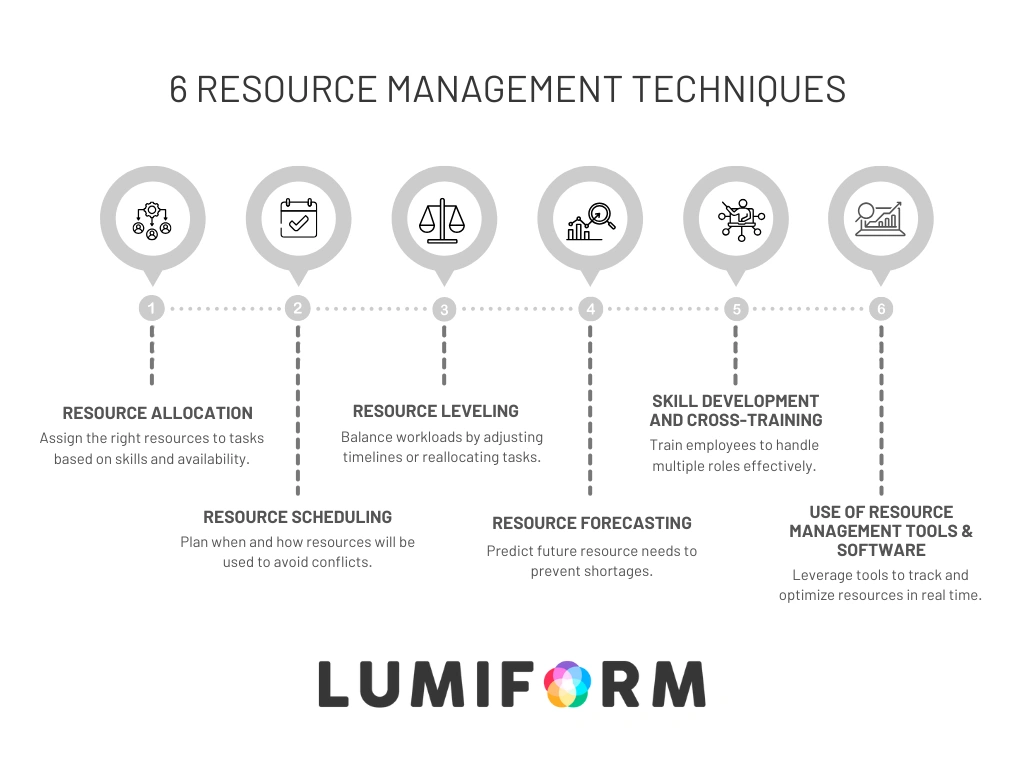As a project manager, team leader, or operations expert, mastering resource management is essential for success. Resource management is the process of strategically allocating and utilizing different resource types—human, financial, physical, and informational (Data and systems supporting decision-making)—prudently to minimize waste and maximize productivity.
Integrating these resources effectively into your management framework ensures your team or company achieves its objectives.
Did you know that inefficient resource management can lead to productivity losses? This guide offers tools to optimize resources, boost your organization’s performance, and drive sustainable growth
Types of resource management approaches
Various approaches can be employed to manage resources effectively, depending on your organizational needs and goals.
- Agile resource management: Emphasizes flexibility and responsiveness, ideal for dynamic projects where requirements frequently change.
- Lean resource management: Focuses on minimizing waste and maximizing value, best suited for improving efficiency and reducing costs.
- Waterfall resource management: Involves sequential planning and execution, suitable for projects with well-defined stages and stable requirements.
- Hybrid resource management: Combines elements of different approaches, tailored for projects that require both flexibility and structure.
Choosing the right approach ensures efficient resource management aligned with strategic objectives.
Key principles of resource management
Aligning resources with strategic goals is fundamental to successful management. Resources must support your organization’s objectives to ensure cohesive progress. Efficiency and effectiveness are key; aim to maximize output while minimizing input.
This requires a focus on productivity and smart resource allocation. Flexibility and adaptability are also important; conditions change, and your resource allocation must be able to adjust accordingly.
Finally, sustainability is essential. Managing resources with a long-term perspective ensures continued success and stability.
Common challenges and pain points
Navigating resource management involves overcoming several common challenges.
- Inefficient resource allocation: Misallocation can lead to wasted opportunities. Match resources to the right tasks and projects.
- Lack of visibility into resource utilization: Without clear insights, identifying inefficiencies is tough.
- Overcoming budget constraints: Financial limitations require innovative solutions and prioritization.
- Balancing competing priorities: Juggle short-term demands with long-term goals.
Addressing these issues head-on will help you streamline operations and improve resource management outcomes.
Understanding resource management fundamentals is crucial for optimizing operations. Each resource type, approach, and key principle helps your team navigate common challenges.
This sets the stage for effective strategies which you will explore in upcoming sections.
Strategic resource planning: Lessons from leading auto EV manufacturer
A notable example of successful resource management in the manufacturing sector comes from Tesla’s Gigafactories. These facilities are central to Tesla’s mission to accelerate the world’s transition to sustainable energy.
The Gigafactories exemplify effective project management techniques. The production incorporated frameworks like Agile and Lean to tackle the complexities of large-scale manufacturing.
Background and challenges:
Tesla faced the immense challenge of scaling its production capabilities to meet the growing demand for electric vehicles and batteries. The complexity of coordinating extensive resources across multiple global sites required innovative solutions to ensure efficiency and sustainability.
Strategy and execution:
Tesla employed Agile methodologies to foster continuous improvement and adaptability, along with Lean principles to eliminate waste and optimize productivity. Detailed planning and resource allocation were crucial, allowing Tesla to efficiently manage the extensive projects associated with its Gigafactories. Stakeholder engagement played a key role, in ensuring alignment and communication across all levels of the organization.
Results and lessons learned:
The strategic application of methodologies at Tesla’s Gigafactories led to significant outcomes and insights, which are essential for understanding effective resource management in large-scale manufacturing:
Results:
- Streamlined operations: Efficient processes were established, enhancing productivity and reducing waste.
- Enhanced resource utilization: Optimal allocation of resources ensured maximum efficiency and effectiveness.
- Maintained competitive edge: Strategic execution helped Tesla remain a leader in the automotive industry.
Lessons Learned:
- Integration of Agile and Lean principles: Combining these methodologies is crucial for managing complex projects.
- Importance of stakeholder engagement: Effective communication and alignment across all levels are vital for achieving project objectives.
These results and lessons provide a blueprint for successful resource management. Each insight emphasizes the need for strategic planning and adaptive methodologies in large-scale manufacturing projects.
Understanding strategic resource planning
Strategic resource planning is a cornerstone of effective management and is essential for aligning resources with your organization’s goals.
As a project manager, operations leader, or resource planner, you must forecast needs, set clear objectives, and utilize tools effectively. This ensures optimal resource allocation, supporting strategic initiatives and enhancing productivity.
Setting clear objectives and goals
Defining precise objectives is the first step in strategic planning. Here’s how clear goals can enhance your resource management:
- Provide direction and focus: Helps prioritize resource allocation effectively.
- Utilize SMART criteria:
- Specific: Clearly define what needs to be achieved.
- Measurable: Establish metrics to track progress.
- Achievable: Ensure goals are realistic and attainable.
- Relevant: Align objectives with broader strategic aims.
- Time-bound: Set deadlines to maintain momentum.
These criteria ensure that goals are actionable, allowing you to transition confidently into forecasting.
Forecasting and demand planning
Accurate forecasting is essential for anticipating and aligning resource needs with your objectives. Industry best practices suggest using historical data, market trends, and predictive analytics to forecast demand.
Techniques such as time-series analysis and regression models are commonly used to enhance accuracy. This proactive approach helps allocate resources efficiently, avoiding shortages or surpluses and ensuring uninterrupted progress toward your goals.
Tools and techniques for effective resource planning
To enhance forecasting and planning, employ industry-standard tools and methodologies.
- Software solutions: Utilize project management and resource planning software, like Microsoft Project or SAP, to streamline processes and improve visibility. These tools are designed to translate forecasts into actionable plans.
- Methodologies: Implement frameworks such as Agile or Lean, recognized for their adaptability and efficiency in optimizing resource use. These methodologies offer flexibility to meet dynamic demands and integrate seamlessly with your objectives and forecasts, creating a cohesive planning strategy.
Strategic resource planning is vital for achieving organizational success. Setting clear objectives, forecasting demand, and leveraging industry-standard tools ensure resources are aligned with strategic goals.
Steps to creating and executing a resource management strategy
In this example, you are the resource manager at XYZ Projects, a mid-sized engineering firm specializing in sustainable infrastructure. Your goal is to create and deploy a resource management strategy that aligns with the company’s strategic objectives and enhances operational efficiency.
Step 1: Assess current resource capabilities
Conduct a thorough evaluation of existing resources at XYZ Projects.
- Conduct a comprehensive resource audit: Use industry-standard tools to identify and catalog available human, financial, physical, and informational resources. Techniques such as SWOT analysis can help pinpoint strengths and weaknesses in resource utilization.
- Analyze resource utilization with precision: Employ data analytics to assess current allocation, identifying inefficiencies and opportunities for optimization.
- Engage with stakeholders through structured interviews: Collect insights from team leaders and department heads using structured interview templates or surveys to understand resource needs and potential gaps.
Step 2: Define strategic objectives
Set clear, impactful goals that align with XYZ Projects’ mission and vision.
- Utilize SMART criteria rigorously: Ensure objectives are Specific, Measurable, Achievable, Relevant, and Time-bound, using industry benchmarks to validate goal setting.
- Prioritize objectives based on strategic impact: Use tools like the Balanced Scorecard to focus on goals that drive the most value for the company.
- Communicate objectives clearly and effectively: Develop a communication plan to share goals with all stakeholders, ensuring alignment and buy-in through workshops and meetings.
Step 3: Create a resource management strategy
Design a comprehensive strategy that outlines resource allocation and utilization.
- Develop a detailed resource management plan: Use advanced techniques such as resource leveling and resource smoothing to map out resource needs and allocation strategies.
- Select appropriate tools and methodologies: Choose project management software like Microsoft Project or Oracle Primavera and frameworks like Agile or Lean to support the strategy.
- Establish governance and oversight mechanisms: Define roles, responsibilities, and processes for monitoring and managing resources effectively.
Step 4: Execute the resource management strategy
Deploy the plan with precision and oversight.
- Launch pilot projects with clear metrics: Test the strategy on smaller projects to refine processes and gather feedback using metrics like cycle time and throughput.
- Monitor progress with robust KPIs: Use key performance indicators (KPIs) to track resource utilization, project milestones, and overall performance.
- Adjust dynamically based on data: Be prepared to make changes based on real-time data and feedback, employing iterative processes to refine execution.
Step 5: Review and optimize continuously
Evaluate and enhance the effectiveness of the resource management strategy.
- Conduct post-implementation reviews with structured methodologies: Use techniques like After Action Reviews or Lessons Learned sessions to analyze outcomes and identify areas for improvement.
- Gather feedback systematically: Engage with team members through surveys and focus groups to understand successes and challenges.
- Implement continuous improvement cycles: Use insights to refine the strategy and enhance resource management practices, employing methodologies like Kaizen or Six Sigma.
Creating and deploying a resource management strategy at XYZ Projects involves a comprehensive approach that starts with assessing capabilities and defining objectives, followed by designing, executing, and optimizing the strategy. Following these steps, you can ensure resources are aligned with strategic goals, driving efficiency and success across the company.
Monitoring and optimization
Monitoring and optimization are crucial for ensuring that resource management strategies remain effective and aligned with organizational goals.
As the Resource Manager at XYZ Projects, it’s essential to track progress, identify areas for improvement, and address challenges proactively.
Key performance indicators (KPIs) for resource management
KPIs are essential for assessing the effectiveness of your resource management strategy. Resource utilization rate measures the percentage of resources actively engaged in tasks, while project completion rate tracks on-time and within-budget completions.
Cost variance evaluates discrepancies between planned and actual expenditures, and employee productivity assesses individual output.
Together, these KPIs offer valuable insights into resource performance, highlighting areas for optimization and improvement.
Continuous improvement practices
Implementing continuous improvement practices ensures that resource management strategies evolve and adapt to changing needs:
- Regular audits and reviews: Conduct frequent evaluations of resource allocation and utilization to identify inefficiencies.
- Feedback loops: Establish channels for receiving input from team members and stakeholders to refine processes.
- Adoption of best practices: Incorporate industry best practices and emerging trends to enhance resource management.
Continuous improvement fosters a culture of excellence and adaptability, ensuring long-term success.
Overcoming common resource management challenges
Addressing challenges like inefficient allocation, lack of visibility, resistance to change, and competing priorities is crucial. Use data-driven decisions, integrated software, stakeholder engagement, and prioritization frameworks to maintain effective management.
Monitoring and optimization are vital for resource management success at XYZ Projects. Leveraging KPIs, continuous improvement, and addressing challenges ensures effective resource utilization, driving efficiency, and achieving strategic goals.
Unlock your organization’s potential with Lumiform
Visualize a transformed organization with seamless resource management. Start today to make that vision a reality. Use Lumiform’s platform to explore and implement strategies with its rich templates, automation features, and audits. Elevate your standards and enhance compliance across business areas.
Click here to start driving sustainable growth and excellence with our resource management tools.

